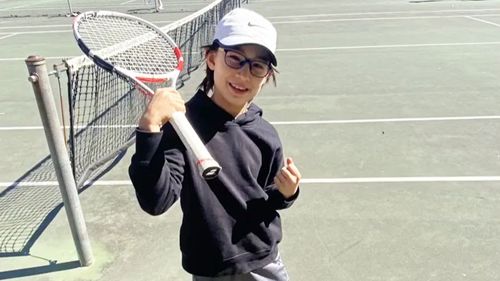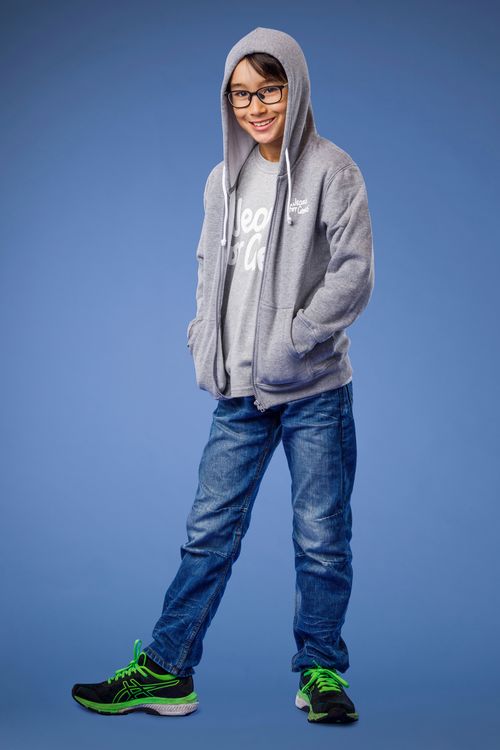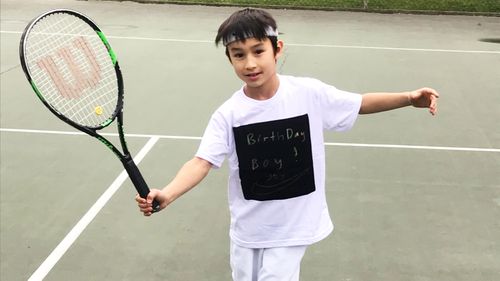The then nine-year-old was out on the court six days a week and had dreams of playing as a professional.
However, it was around this time that Arato’s coach noticed something strange.
His young athlete was suddenly missing shots he would have nailed a year earlier.

“Arato’s coach was struggling to find an explanation and it rang alarm bells,” his father, Tim Green, said.
Green immediately had a suspicion of what was wrong, but it was something he had been assured by experts was extremely unlikely to happen.
Close to 25 years ago, Green had himself been diagnosed with a rare genetic eye condition called Stargardt’s disease.
The disease affects the macula and causes broad central vision loss.
At the time Green was diagnosed, he was told there was almost no chance he would pass on his eye condition to any future children he may have.
“I was told that it’s recessive, and therefore, I wouldn’t have to be concerned that my children would inherit this genetic problem,” he said.

Research scientists have since discovered there are some forms of Stargardt’s disease caused by dominant genes.
Despite being told not to worry all those years ago, Green said he did get Arato tested by an ophthalmologist when he was about six years old and began showing a passionate interest in tennis.
The tests showed Arato had normal eyesight at the time.
Arato was given more tests a few years later, when his coach raised the alarm, which confirmed he did indeed have Stargardt’s disease and was displaying early signs of vision loss.
Arato’s journey has in some ways mirrored his father’s, despite him being diagnosed at a far younger age.
Green was also diagnosed with Stargart’s disease while training to become a professional athlete – in his case, competing in triathlons and ironman events.
“I was in full training for an ironman event at the time,” Green said.
“I started tripping over and riding over things, which was what prompted me to see an ophthalmologist to be tested.”
Arato, who is now 10, is one of the faces for this year’s Jeans for Genes Day, to be held this Friday.
The annual campaign raises funds for the Sydney’s Children’s Medical Research Institute.

Although there is currently no cure for Stargardt’s disease, Green said the advances made through medical research towards finding a possible treatment was one of the things that gave him hope for Arato’s future.
“When I was diagnosed, there was no follow up. I was told there is nothing that we can do for you,” he said.
“But the conversation is very different now. You are advised to actually keep in contact with the clinicians because there are clinical trials happening.
“Science has come a long way and, in the conversations we’ve had with clinicians with respect to Stargardt, we are very hopeful in the next decade that there will be effective treatments.”
Green said his son had so far coped “exceptionally well” with his difficult diagnosis.
“He is taking things in his stride. There’s advantages and disadvantages to being diagnosed at a relatively young age, I think kids are pretty resilient and adaptable.”
Green said Arato was still playing tennis recreationally and was also enjoying taking part in a blind and low vision tennis (BLV) competition, run by Tennis Australia.
At school, things were a bit more of a challenge, with Arato needing vision aids in the classroom to see his work.
While Stargardt’s disease affects central vision, Green and his son are like many with the condition who have retained peripheral vision.
“I can still navigate myself around an environment that I’m familiar with, but I struggle on the stairs, because I can’t see the end of the step, or the depth,” Green explained.
“For Arato, at school it’s hard for people to understand why he can play handball so well, but he can’t read the whiteboard.
“Or when they play soccer he can see the ball, but he might kick it to the wrong person because he can’t see faces.”

Green said while living with Stargardt’s disease had presented him with plenty of challenges it had also opened up new and unexpected opportunities.
It was a chance conversation with the ophthalmologist who diagnosed him that led Green on the path to becoming a lawyer.
“We were talking about what my future would look like and he said to me, ‘Tim, the best thing you can do is go get yourself a good education and then you’ll always have a good job.’
“I have suggested becoming a lawyer and, indeed, that’s what I went and pursued.”
Green also recently took part in an ironman event in order to raise funds for Jeans for Genes Day and demonstrate for his three guiding principles he says he lives by – courage, commitment and resilience.
“When you have those three principles and values you can still achieve a lot of things,” Green said.
Money raised will go towards the Eye Genetics Research Unit at the Children’s Medical Research Institute, where scientists have developed the first ever gene therapy for a blinding eye condition in Australia and are researching new treatments for several forms of genetic blindness.